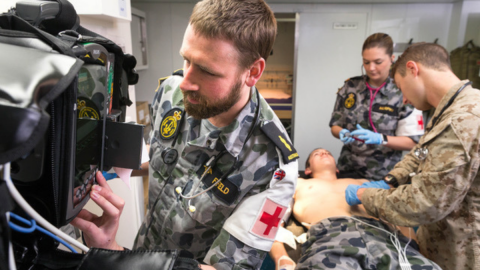In part one of this two-part series, I argued that the Australian Army must make Humanitarian Assistance and Disaster Relief (HADR) operations part of the strategic plan for how the Australian Army prepares for the future. Here I will show how Army can use its health assets to prepare a capable and well-equipped force that is both ready now and future-ready within the concept of Accelerated Warfare.
The Australian Army needs to consider how it will prepare a future-ready force that is capable of delivering HADR effects. We need to start planning how to intellectually prepare our people, how to implement existing technology and how to prepare for future technology. The likely frequency of natural disasters in Australia’s region will also present an opportunity to prove new and developing technologies under operational conditions.
Responding to the future requirements of HADR preparedness, it is important that Army’s Health Professionals (AHP) have the experience and training to effectively plan and respond to disasters. AHPs need to be capable of operating as part of a joint force and being interoperable with other government agencies, non-government and international organisations and coalition partners.[1] While there are currently ADF secondments to DFAT, further secondments or internships for AHPs to DFAT and their partner organisations such as the Australian Medical Assistance Team and DFAT approved Non-Government Organisations would enhance interoperability and WoG synergy.
The Australian Army can improve HADR responses through the use of existing new technologies in the areas of telemedicine and drone or Unmanned Aerial Vehicles (UAV) technology. During disaster events, one of the greatest challenges is communication and the inability to collect, analyse and communicate important information. Morbidity and mortality can be improved through the accuracy and timeliness of information.[2] Telemedicine during HADR operations has the potential to save lives and improve health outcomes in areas of operations where health services and infrastructure have been damaged, destroyed or overwhelmed. The improvements in electronic and communications technology now make use of telemedicine in remote areas a possibility, and one which could be leveraged by AHPs to improve HADR operations. Once proved in HADR these technologies can be transferred to other types of operations.
The potential use of telemedicine during HADR operations is significant and can act as a force multiplier by enabling the limited specialists and medical officers the ability to deliver health effects in multiple places at once. The information gathered through telemedicine also possesses the potential to support disaster needs assessment and triaging during times where medical support will be in high demand.
Drones and UAVs are other existing and rapidly developing technology with broad potential for use in support of HADR operations. Most disaster-affected areas will have suffered significant damage to infrastructure, resulting in impassable roads and inoperable rail networks. This is a complicating factor in providing aid to affected regions. During disaster events, there is an increased need for both blood and pharmaceuticals at a time when supply is critically affected. Drones and UAVs have the potential to quickly and easily deliver medical supplies in a timely fashion to areas in urgent need. Items such as blood products and pharmaceuticals could be delivered to mass casualty locations, outlying health facilities and either to or from offshore ships.
While telemedicine, UAVs and drone technology exist now, the two scientific advances that are expected to profoundly affect societies and militaries in the future are robotics and Artificial Intelligence (AI). The Australian Army needs to be acting now so it can progress towards having effective future AI. AI’s foreseeable benefit for HADR operations is the synthesis of data to predict impending disaster effects to support preparations and planning. AI could also analyse and model disaster-affected areas to determine the priority of need or effort, predict areas at risk of a disease outbreak, and to build a greater understanding of the operating environment through synthesised analysis of physical and human terrain.
In November 1957, an article was written in the Hammond Times titled Work With New Electronic Brains Opens Field for Army Math Experts.[3] The article discussed how U.S. Army computer programmers were using mathematical formulas programmed into computers to solve complex problems. That is where the now famous saying computer saying of ‘garbage in, garbage out’ or GIGO comes from. This was a problem that computer programmers were facing and discussing in the very early stages of computer development. The same problem exists 61 years later. How does the Australian Army capture high-quality operational data now to ensure that future AI systems have the required knowledge to leverage an advantage?
The statistics on the frequency of disaster events in the Australian region demonstrate that the Australian government, the ADF and the Australian Army will undertake multiple HADR operations before AI technology is operationally capable. The data captured and stored from those disaster events will be what supports AI decisions and recommendations 10 to 30 years from now.
Given the frequency of HADR operations is likely to increase, development of a near and far term plan to make the Australian Army a more capable HADR force is a necessity. Greater interagency cooperation, implementation of existing new technology, and data capturing now for future AI systems are all examples of how the Australian Army can become a more future-ready force. While this article is focussed on the importance of being prepared for HADR operations, it is easy to conclude that the advantages gained from WoG synergy and technological advancement in reoccurring HADR operating environments will be transferrable to future combat operations.
[1] Australian Army, Land Capability Modernisation Plan 2017 (Unclassified Version), 2017, p. 19.
[2] A. Chaturvedi and J. Sundresh, ‘A Study on Telemedicine and its Importance During Disaster management in North Eastern Region’, Global Journal for Research Analysis, vol. 7, no. 1, 2018, p. 431.
[3] Unknown Author, ‘Work With New Electronic ‘Brains’ Opens Field For Army Math Experts’, Hammond Times, available from Newspaper Archive (accessed 09 November 2018).




